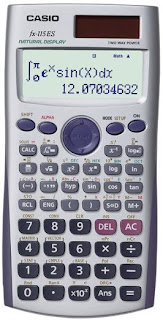In my previous post about finding the roots of polynomials, I wrote that no general solution exist for polynomials whose degree is higher than 4. However, we still need to be able to find the roots of these polynomials. In this post I want to talk about some of the methods for finding roots, and about their limitations.
Finding the roots of polynomial might sound an abstract goal, but it is actually a very practical one. Look on the following problem for example - Given a line segment of length one AC, divide it in two parts AB and BC in such a way that AC/AB=AB/BC. This is a purely geometrical problem, but its solution is equivalent to solving the following equation:
x^2+x-1=0
Lets look on the following quintic equation (fifth degree polynomial):
This one cannot be solved using a formula. But it is obvious that 1 a root of this polynomial. However, such a polynomial must have five roots (according to the basic theorem of algebra). What can ! we do to find them? A simple way would be to try to divide thi! s polyno mial by x-1. After such division, the degree of the polynomial we need to solve becomes less by one. We will get then that our original polynomial can be written as:
So, we got now a problem which is very easy to solve. All we need to do is to use the formula we know for the forth degree polynomial, and we are done. If we don't remember the formula, we can try to guess another root, lest call it y. and then divide by x-y. For this polynomial, it is again obvious that 1 is a root. So we can divide by x-1 again. We get:
If this is still too complicated, we can divide again.
I wanted the above e! xample to be as simple as possible, so I selected the polynomial (x-1)^5. However, what about more complex examples? It is practical to try to solve some random polynomial in this way? The answer to this is yes. Firstly, we can always divide two polynomials. This result we get from a theorem I don't want to talk about now. Secondly, while it is often impossible to guess the root, this is a rather practical approach. Unless all of the roots are irrational, the chances to guess them are pretty good (especially if you get this question in an exam). The reason for this is that the last monom (the free number) must be multiplication of all the roots, and the second must be minus the sum of all the roots. In the polynomial I solved above, for example the roots are (1,1,1,1,1). There sum is 5 and there multiplication is 1. And in the polynomial this is exactly what we get - in the second place we have (-5x^4) and in the last we have 1.
Lets look on the following polynom! ial:
This particular polynomial cannot be solved by the method specified. The reason for this is very simple - are the roots are complex. For complex roots there is a very interesting property - if, lets say, (2-i) is a root than (2+i) is also a root. This makes the process slightly easier. If you guess one root you get another one as a bonus. Now, I don't know about you, but I have no idea what are the roots of this particular polynomial, and I don't know how to find then.
So why I am saying that the method I presented in which you need to guess a root is practical? It is only practical when you need to solve a polynomial that is "nice and easy". If the polynomial you need to solve cannot be solved by simply guessing, it is better to use the computer to find the solution or at least an approximation to the solution. Unfortunately, this is the only ! thing we can do without a closed formula.
The problem we have with the quintic, and other polynomials is not unique. We have similar problem with integrals. It is often perfectly clear that an integral have a solution, but we have no way to find it. For example:
It is proven that this integral cannot be written using elementary functions, but it exists. And there are many others like this one. In modern mathematics there are more than enough things that are proved to be impossible, but we would like them to be possible. And this is (in my opinion) a strong argument for the claim that math is discovered and not invented - we get result which are hardly expected or desired.
In the next post I will write about how simple polynomials were solved in the ancient world, and I will also ! try to find time to write about the formulas for the third and! forth d egree.
solve polynomials
